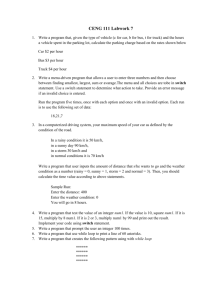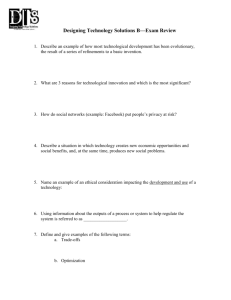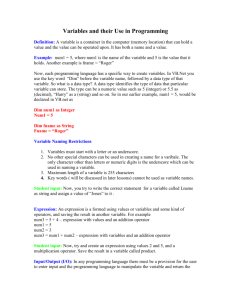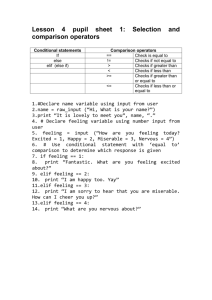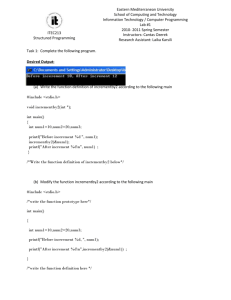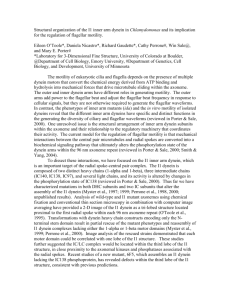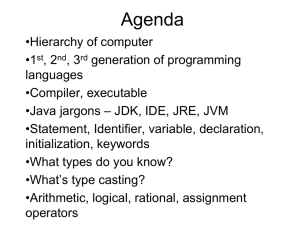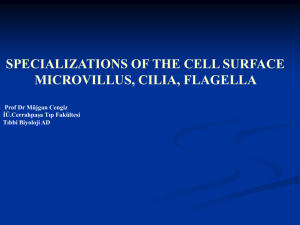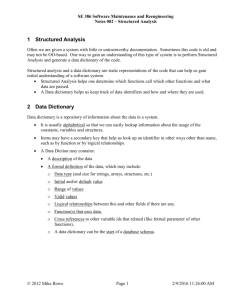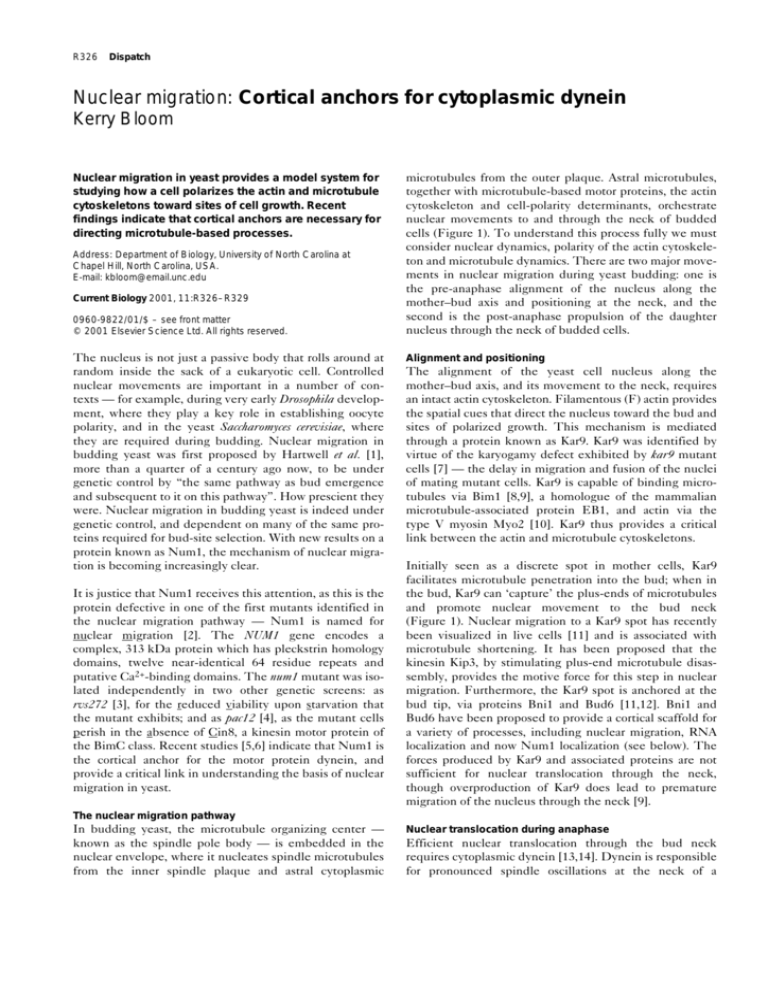
R326
Dispatch
Nuclear migration: Cortical anchors for cytoplasmic dynein
Kerry Bloom
Nuclear migration in yeast provides a model system for
studying how a cell polarizes the actin and microtubule
cytoskeletons toward sites of cell growth. Recent
findings indicate that cortical anchors are necessary for
directing microtubule-based processes.
Address: Department of Biology, University of North Carolina at
Chapel Hill, North Carolina, USA.
E-mail: kbloom@email.unc.edu
Current Biology 2001, 11:R326–R329
0960-9822/01/$ – see front matter
© 2001 Elsevier Science Ltd. All rights reserved.
The nucleus is not just a passive body that rolls around at
random inside the sack of a eukaryotic cell. Controlled
nuclear movements are important in a number of contexts — for example, during very early Drosophila development, where they play a key role in establishing oocyte
polarity, and in the yeast Saccharomyces cerevisiae, where
they are required during budding. Nuclear migration in
budding yeast was first proposed by Hartwell et al. [1],
more than a quarter of a century ago now, to be under
genetic control by “the same pathway as bud emergence
and subsequent to it on this pathway”. How prescient they
were. Nuclear migration in budding yeast is indeed under
genetic control, and dependent on many of the same proteins required for bud-site selection. With new results on a
protein known as Num1, the mechanism of nuclear migration is becoming increasingly clear.
It is justice that Num1 receives this attention, as this is the
protein defective in one of the first mutants identified in
the nuclear migration pathway — Num1 is named for
nuclear migration [2]. The NUM1 gene encodes a
complex, 313 kDa protein which has pleckstrin homology
domains, twelve near-identical 64 residue repeats and
putative Ca2+-binding domains. The num1 mutant was isolated independently in two other genetic screens: as
rvs272 [3], for the reduced viability upon starvation that
the mutant exhibits; and as pac12 [4], as the mutant cells
perish in the absence of Cin8, a kinesin motor protein of
the BimC class. Recent studies [5,6] indicate that Num1 is
the cortical anchor for the motor protein dynein, and
provide a critical link in understanding the basis of nuclear
migration in yeast.
microtubules from the outer plaque. Astral microtubules,
together with microtubule-based motor proteins, the actin
cytoskeleton and cell-polarity determinants, orchestrate
nuclear movements to and through the neck of budded
cells (Figure 1). To understand this process fully we must
consider nuclear dynamics, polarity of the actin cytoskeleton and microtubule dynamics. There are two major movements in nuclear migration during yeast budding: one is
the pre-anaphase alignment of the nucleus along the
mother–bud axis and positioning at the neck, and the
second is the post-anaphase propulsion of the daughter
nucleus through the neck of budded cells.
Alignment and positioning
The alignment of the yeast cell nucleus along the
mother–bud axis, and its movement to the neck, requires
an intact actin cytoskeleton. Filamentous (F) actin provides
the spatial cues that direct the nucleus toward the bud and
sites of polarized growth. This mechanism is mediated
through a protein known as Kar9. Kar9 was identified by
virtue of the karyogamy defect exhibited by kar9 mutant
cells [7] — the delay in migration and fusion of the nuclei
of mating mutant cells. Kar9 is capable of binding microtubules via Bim1 [8,9], a homologue of the mammalian
microtubule-associated protein EB1, and actin via the
type V myosin Myo2 [10]. Kar9 thus provides a critical
link between the actin and microtubule cytoskeletons.
Initially seen as a discrete spot in mother cells, Kar9
facilitates microtubule penetration into the bud; when in
the bud, Kar9 can ‘capture’ the plus-ends of microtubules
and promote nuclear movement to the bud neck
(Figure 1). Nuclear migration to a Kar9 spot has recently
been visualized in live cells [11] and is associated with
microtubule shortening. It has been proposed that the
kinesin Kip3, by stimulating plus-end microtubule disassembly, provides the motive force for this step in nuclear
migration. Furthermore, the Kar9 spot is anchored at the
bud tip, via proteins Bni1 and Bud6 [11,12]. Bni1 and
Bud6 have been proposed to provide a cortical scaffold for
a variety of processes, including nuclear migration, RNA
localization and now Num1 localization (see below). The
forces produced by Kar9 and associated proteins are not
sufficient for nuclear translocation through the neck,
though overproduction of Kar9 does lead to premature
migration of the nucleus through the neck [9].
The nuclear migration pathway
In budding yeast, the microtubule organizing center —
known as the spindle pole body — is embedded in the
nuclear envelope, where it nucleates spindle microtubules
from the inner spindle plaque and astral cytoplasmic
Nuclear translocation during anaphase
Efficient nuclear translocation through the bud neck
requires cytoplasmic dynein [13,14]. Dynein is responsible
for pronounced spindle oscillations at the neck of a
Dispatch
R327
Figure 1
G1
Kar9-assisted
microtubule
search and capture
M
Nuclear migration
to the neck
AO
Dynein, anchored to
cortical sites by Num1,
powers the spindle
through the neck
LA
Spindle elongation
to distal end of
mother and budded cell
G1
Cytokinesis and return
to microtubule
search and capture
Current Biology
Num1 anchors cytoplasmic dynein and contributes to spindle
elongation in anaphase. The nucleus (blue sphere) is propelled by
astral microtubules (green lines) pushing against the cell periphery
(G1). Cytoplasmic dynein fused to GFP (not shown) decorates the
astral microtubule lattice. Migration to the neck of budded cells is
facilitated by Kar9 (gray spheres in G1 and M phase cells), which
serves as a linker between actin and microtubule cytoskeletons (see
text). Num1 (red sphere) is present in the cortex of unbudded cells,
and appears in the bud of medium to large budded cells (M phase
and anaphase onset, AO). Num1 is a cortical protein that binds
tubulin and dynein (AO and late anaphase, LA). If dynein is
immobilized by Num1, the minus-end directed translocation of
microtubules by dynein would result in movement of the spindle pole
and nucleus to cortical sites (late anaphase). Upon spindle
disassembly, astral microtubule growth propels the nucleus for the
next cycle.
budded cell, and contributes to the forces required to pull
the nucleus and chromatin DNA through the aperture
between mother cell and bud [15]. Dynein is also required
for the prominent microtubule sliding that is seen at this
stage of the cell cycle [16]. Dynein is symmetrically
distributed along the length of both mother and daughter
cell microtubules, and is unlikely to provide directional
cues itself. The challenge in the field has been to
understand how dynein generates any motive force, and in
particular how it is responsible for microtubule sliding
along the cortex.
green fluorescent protein (GFP) fusions and studies of
protein–protein interactions to reveal the role of Num1 in
nuclear migration. The Num1 protein is initially localized
in the cortex of the mother cell [19]. But using Num1–GFP
fusions, two groups [5,6] have recently observed Num1
accumulation in the bud of large budded cells. Num1–GFP
first appears in medium-sized buds as stationary cortical
spots [5]. The sessile nature of Num1, as well as its predominance in the mother cortex, distinguishes it from
other proteins implicated in nuclear migration and cell
polarity, including Bud6, Bni1 and Kar9.
There are numerous protein candidates that anchor
dynein to cortical (or other) sites. The most notable
include the intermediate and light chains of the dynein
complex itself, and components of the dynein-associated
dynactin complex — in particular, Nip100 (p150), Jnm1
and Act5 (Arp1). Unfortunately for these models, the
dynein heavy chain, Dhc1/Dyn1, localizes to the cytoplasmic microtubules, and despite the effort of several laboratories, there is no evidence for the localization of dynein to
the cortex in yeast. Similarly, several dynactin components
have been localized to the spindle pole body [17,18]. Dynactin at the pole may mediate interactions between
dynein and components at the neck, but this does not
help us understand dynein’s role in microtubule sliding
along the cortex.
Num1 is thus well positioned to be a cortical anchor for
cytoplasmic dynein. Direct evidence supporting this idea
has come from analysis of microtubule sliding [16].
Microtubule sliding along the cortex, as visualized with
tubulin–GFP, is abrogated in the absence of functional
Num1 [5]. Genetic interactions confirm that num1 mutants
behave as if they are missing dynein function [6]. In particular, num1 dynein double mutants behave like either single
mutant, and conversely the double mutants num1 kar9,
num1 bni1 or num1 kip3 behave, respectively, like dynein
kar9, dynein bni1 or dynein kip3 [6,12,15,20]. These results
place Num1 on the dynein pathway of nuclear migration.
Cortical anchors for dynein
Num1, like many of the proteins involved in nuclear
migration, contributes to the efficiency of nuclear migration but is not required for cell viability. It has taken
careful inspection in live cells, protein localization using
What then is the specific evidence that Num1 provides a
cortical anchor for dynein? Direct physical interactions
between Num1 and components of the dynein complex
were examined by co-immunoprecipitation experiments
[6]. Num1 was found to co-immunoprecipitate with the
dynein intermediate chain Pac11, and with the alpha
tubulin Tub3. Furthermore, Num1 co-immunoprecipitates with Bni1 and Kar9. The interactions with Pac11 and
R328
Current Biology Vol 11 No 8
Tub3 indicate that Num1 may indeed provide the anchor
for dynein in the cortex. The functional significance of
Num1’s apparent interactions with Kar9 and Bni1 is less
obvious; consistent with this finding, however, is the observation that Num1–GFP localization is dependent on
BNI1, in particular Num1 was seen to relocalize from the
tip of the bud to the neck in bni1 mutants.
These observations support the proposed roles for Bud6
and Bni1 as components of a general cortical scaffold,
which perhaps now should include Num1 as a specific
effector for dynein. The relocalization of Num1 from the
tip of the bud to the neck in bni1 mutants mirrors the
similar relocalization of Bud6 in bni1 cells [21]. Loss of
Bni1 is accompanied by increased microtubule interactions with the neck region [21]. Thus, microtubule interactions are dependent upon Bni1 anchoring Bud6 and
Num1 to the bud tip. The default position for Bud6 and
Num1 in bni1 cells may be the neck, which is possibly
indicative of secondary anchors at this site.
The second indication that Num1 has a role in anchoring
dynein is the loss of dynein-dependent spindle oscillations in num1 mutants. In wild-type cells arrested with
the DNA synthesis inhibitor hydroxyurea, the nucleus
becomes closely apposed to the neck, whereas it is displaced from the neck in hydroxyurea-treated num1 cells
[3]. Similarly, nuclei are displaced from the neck in dynein
mutants treated with hydroxyurea [14]. While there may
be secondary anchors at the neck for dynein, these data
are consistent with the idea that Num1 and dynein contribute to dynein-dependent nuclear motility prior to the
onset of anaphase.
How does an anchor embedded in the cortex facilitate
microtubule sliding along the cortex? The inferred dynein
localization to microtubules has to be cautiously interpreted, given that the observations are based on GFP
fusion proteins and the attached GFP could disrupt
dynein’s normal interactions. The interactions between
dynein and Num1 may be very transient, with dynein
generating its power stroke while engaged with Num1.
The problem is the relatively sparse distribution of Num1
in the bud, and moreover its prominence at the tip. Much
of the reported microtubule sliding can be seen along the
bud cortex, indicating either that active Num1 is more
widely distributed in the bud, but generally below the
limits of detection, or that a few contact sites in the cortex
suffice to anchor the motor.
Num1’s localization at the bud tip as well as in the
mother cell indicates that it might have two functional
states: a Bni1-dependent state at the bud tip, and a Bni1independent state in the mother cell. The tip-localized
Num1 could serve as the anchor for dynein and facilitate
spindle elongation. The mother-cell-localized Num1 may
be inactive until anaphase onset, or perhaps in a different
(Bni1-independent) conformation and serve a different
role in unbudded cells.
Two structural features of Num1 suggest that the motherbound form of the protein may have cortex-binding sites.
Firstly, the pleckstrin homology domains may be important for interactions with the membrane lipid phosphatidylinositol-4,5-bisphosphate, and Num1 has been
shown to physically interact with phospholipase C [22].
And secondly, the twelve 64-residue repeats, which
resemble the partially conserved tetratricopeptide repeats
(TPRs) found in members of the anaphase-promoting
complex, suggest that Num1 may be part of a larger multisubunit complex. At least one of these repeats is required
for exogenous Num1 to suppress the nuclear migration
defect of num1 mutants [19], and while the repeat number
varies in different yeast strains, ranging from 1–24 copies,
all variants contain at least one repeat.
While the mechanism of action of Num1 remains elusive,
the discovery that this protein is localized in the yeast cell
bud, and careful examination of the num1 mutant phenotype, have revealed an important player in nuclear positioning and migration to the bud. The field can now turn
its attention to how cytoplasmic dynein, bound along
dynamically growing and shortening microtubules, gets
‘captured’ by the Num1 anchor and powers the nucleus
toward its destiny in the bud.
References
1. Hartwell LH, Culotti J, Pringle JR, Reid BJ: Genetic control of the cell
division cycle in yeast. Science 1974, 183:46-51.
2. Kormanec J, Schaaff-Gerstenschlager I, Zimmermann FK, Perecko D,
Kuntzel H: Nuclear migration in Saccharomyces cerevisiae is
controlled by the highly repetitive 313 kDa NUM1 protein. Mol Gen
Genet 1991, 230:277-287.
3. Revardel E, Aigle M: The NUM1 yeast gene: length polymorphisms
and physiological aspects of mutant phenotype. Yeast 1993,
9:495-506.
4. Geiser JR, Schott EJ, Kingsbury TJ, Cole NB, Totis LJ,
Bhattacharyya G, He L, Hoyt MA: Saccharomyces cerevisiae genes
required in the absence of the CIN8-encoded spindle motor act in
functionally diverse mitotic pathways. Mol Biol Cell 1997,
8:1035-1050.
5. Heil-Chapdelaine RA, Oberle JR, Cooper JA: The cortical protein
Num1p is essential for dynein-dependent interactions of
microtubules with the cortex. J Cell Biol 2000, 151:1337-1343.
6. Farkasovsky M, Kuntzel H: Cortical Num1p interacts with the dynein
intermediate chain Pac11p and cytoplasmic microtubules in
budding yeast. J Cell Biol 2001, 152:251-262.
7. Miller RK, Rose MD: Kar9p is a novel cortical protein required for
cytoplasmic microtubule orientation in yeast. J Cell Biol 1998,
140:377-390.
8. Lee L, Tirnauer JS, Li J, Schuyler SC, Liu JY, Pellman D: Positioning
of the mitotic spindle by a cortical-microtubule capture
mechanism. Science 2000, 287:2260-2262.
9. Korinek WS, Copeland MJ, Chaudhuri A, Chant J: Molecular linkage
underlying microtubule orientation toward cortical sites in yeast.
Science 2000, 287:2257-2259.
10. Yin H, Pruyne D, Huffaker TC, Bretscher A: Myosin V orients the
mitotic spindle in yeast. Nature 2000, 406:1013-1015.
11. Beach DL, Thibodeaux J, Maddox P, Yeh E, Bloom K: The role of the
proteins Kar9 and Myo2 in orienting the mitotic spindle of
budding yeast. Curr Biol 2000, 10:1497-1506.
Dispatch
12. Miller R, Matheos D, Rose M: The cortical localization of the
microtubule orientation protein, Kar9p, is dependent upon actin
and proteins required for polarization. J Cell Biol 1999,
44:963-975.
13. Carminati JL, Stearns T: Microtubules orient the mitotic spindle in
yeast through dynein-dependent interactions with the cell cortex.
J Cell Biol 1997, 138:629-641.
14. Yeh E, Skibbens RV, Cheng JW, Salmon ED, Bloom K: Spindle
dynamics and cell cycle regulation of dynein in the budding yeast,
Saccharomyces cerevisiae. J Cell Biol 1995, 130:687-700.
15. Yeh E, Yang C, Chin E, Maddox P, Salmon ED, Lew DJ, Bloom K:
Dynamic positioning of mitotic spindles in yeast: role of
microtubule motors and cortical determinants. Mol Biol Cell 2000,
11:3949-3961.
16. Adames NR, Cooper JA: Microtubule interactions with the cell
cortex causing nuclear movements in Saccharomyces cerevisiae.
J Cell Biol 2000, 149:863-874.
17. Kahana JA, Schlenstedt G, Evanchuk DM, Geiser JR, Hoyt MA,
Silver PA: The yeast dynactin complex is involved in partitioning
the mitotic spindle between mother and daughter cells during
anaphase B. Mol Biol Cell 1998, 9:1741-1756.
18. McMillan JN, Tatchell K: The JNM1 gene in the yeast
Saccharomyces cerevisiae is required for nuclear migration and
spindle orientation during the mitotic cell cycle. J Cell Biol 1994,
125:143-158.
19. Farkasovsky M, Kuntzel H: Yeast Num1p associates with the
mother cell cortex during S/G2 phase and affects microtubular
functions. J Cell Biol 1995, 131:1003-1014.
20. Cottingham FR, Hoyt MA: Mitotic spindle positioning in
Saccharomyces cerevisiae is accomplished by antagonistically
acting microtubule motor proteins. J Cell Biol 1997,
138:1041-1053.
21. Segal M, Bloom K, Reed SI: Bud6 directs sequential microtubule
interactions with the bud tip and bud neck during spindle
morphogenesis in Saccharomyces cerevisiae. Mol Biol Cell 2000,
11:3689-3702.
22. Ansari K, Martin S, Farkasovsky M, Ehbrecht I-M, Kuntzel H:
Phospholipase C binds to the receptor-like GPR1 protein and
controls pseudohyphal differentiation in Saccharomyces
cerevisiae. J Biol Chem 1999, 274:30052-30058.
R329

